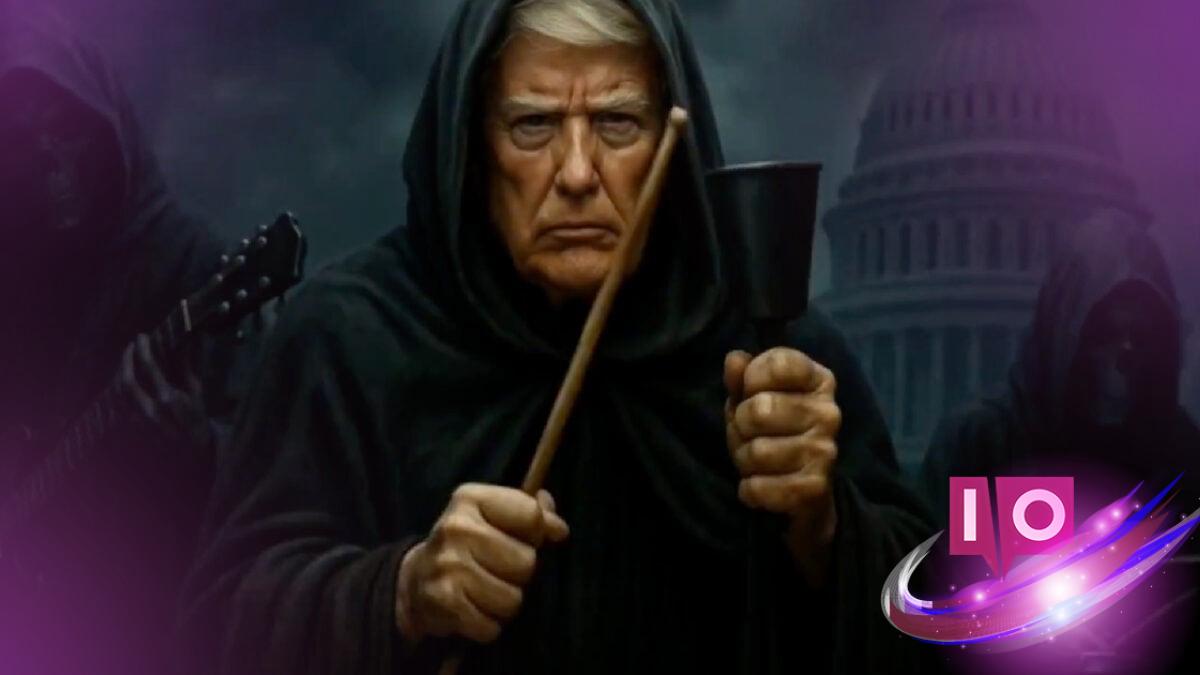Late Thursday, President Donald Trump shared some new and unexpected videos on Truth Social, continuing his trend of delivering peculiar content to the public. Among these, one stood out: an AI-generated clip portraying OMB Director Russ Vought as the Grim Reaper, with Trump enthusiastically playing a cowbell.
Posted at around 10:40 p.m. ET, the video is set to a parody of Blue Öyster Cult’s iconic 1976 hit, “Don’t Fear the Reaper.” Its visuals capture a stormy U.S. Capitol scene, featuring ominous figures cloaked in black robes.
In a surreal twist, one of the figures is President Trump himself, cheerfully hitting a cowbell out of sync with the track while Russ Vought is depicted as the Reaper. Notably, Vought was instrumental in shaping Project 2025, a conservative strategy aimed at significantly reducing the role of the federal government—a plan that has been a contentious topic throughout the 2024 presidential campaign.
The lyrics open with a striking line: “Now their time has come. Here, the power’s gone,” dramatically introducing Vought as the menacing figure wielding “the pen, the funds, and the brain.” As the tune progresses, it portrays Democrats unfavorably, reinforcing the notion that Vought is poised to implement substantial cuts to federal jobs. Two sombreros appear in the video, a nod to a meme often circulated among the far-right.
Trump and his allies have frequently blamed Democrats for the ongoing government shutdown, alleging that they aim to divert funds to provide health care for undocumented immigrants. But this accusation is misleading and has been repeatedly refuted. Currently, the shutdown is on its third day, with no resolution in sight despite Republican control over both the House and Senate.
Trump just posted an AI-generated video depicting Russ Vought as the grim reaper, set to Don’t Fear the Reaper
— Matt Novak (@paleofuture.bsky.social) October 2, 2025 at 7:43 PM
The video appears to have been produced by the Dilley Meme Team, a group known for creating pro-Trump content while also engaging with QAnon-related narratives. Interestingly, the depiction of Vought as the Grim Reaper does not present him as a hero but more accurately reflects his aggressive fiscal agenda. Vought has previously asserted his intention to induce anxiety among federal employees, asserting that he aims to leave them feeling villainized.
“We want the bureaucrats to be traumatically affected,” he stated ahead of the 2024 election. “When they wake up in the morning, we want them to not want to go to work.” This video, inherently portraying Vought in a dark light, is an apt reflection of his public persona.
Furthermore, Vought’s threats about cutting funding for federal agencies have not resonated as ominously as they once might have. Trump has made significant cuts to the federal workforce and programs both domestically and internationally, raising questions about how much more can be diminished.
There’s also uncertainty surrounding whether Trump is fully cognizant of the bizarre content being shared from his accounts. Recently, an AI-generated clip showcasing Trump promoting “med beds”—a QAnon-adjacent concept suggesting miraculous cures for diseases—caught attention. Yet another recent video featured him tossing a “Trump 2028” hat onto Rep. Hakeem Jeffries, the House’s top Democrat.
Another AI video from Trump on Truth Social, this time of his throwing a Trump 2028 hat onto Hakeem Jeffries’ head.
— Matt Novak (@paleofuture.bsky.social) October 2, 2025 at 8:41 PM
The visuals in the latest video hint at its artificial nature—after all, it seems unlikely Trump could execute such a precise hat toss. As the prevalence of sophisticated AI technology continues to rise, discerning reality from fabrication will become increasingly challenging. Recent advancements, like OpenAI’s Sora app, offer tools to create incredibly convincing video content, indicating that the future may hold even more outlandish representations.
While Trump’s circle seems to revel in creating memorable media, the implications of such antics haven’t gone unnoticed. A recent exchange with Speaker of the House Mike Johnson inquired whether their trolling methods undermine the seriousness of political discourse. Johnson attempted to frame the use of memes as a lighthearted response to the “absurdity” of Democratic positions, asserting that some may find it entertaining, but the decisions at stake are significant.
“What they’re trying to have fun with, trying to make light of, is to point out the absurdity of the Democrats’ position. And they’re using memes and all the tools of social media to do that,” Johnson remarked, attempting to justify his party’s approach.
Fox News reporter to Mike Johnson: “How can you say ‘they take no pleasure in this,’ and then the next minute say, ‘Oh, they’re just having fun and trolling?'” pic.twitter.com/O9FyURrnTb
— Aaron Rupar (@atrupar) October 3, 2025
The evolving landscape of political media, especially through the lens of AI, highlights the disconnect between light-hearted portrayals and serious ramifications. It’s a reminder of how entertainment can influence public perception and the gravity of political issues at stake.
What strategies are being used to convey political messages in light of increasing technological advancements? Staying informed is essential as political narratives can evolve swiftly, often leaving a trail of misinformation in their wake.
Do memes and social media primarily serve as legitimate avenues for political discourse? They can be powerful tools for highlighting issues, but they also risk trivializing important discussions. Understanding this balance will be crucial in navigating future political conversations.
In a rapidly changing environment where AI and media intersect, remember to trust your instincts and seek out credible sources for news and insights.
If you’re intrigued by these evolving narratives, consider diving deeper into related topics at Moyens I/O. Your journey through this complex media landscape starts here.
